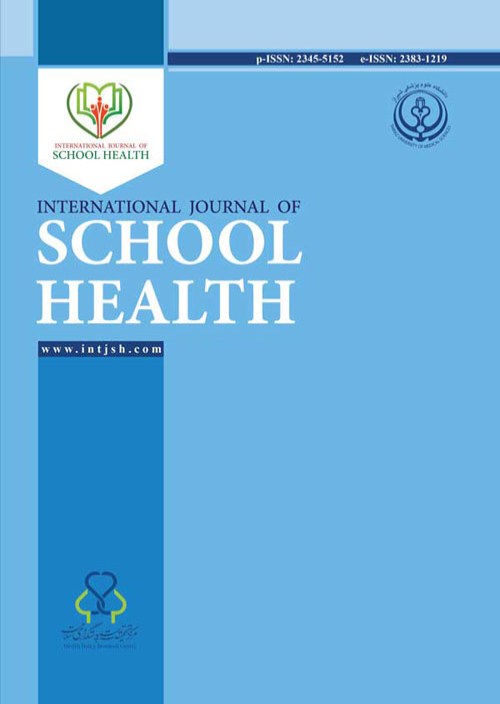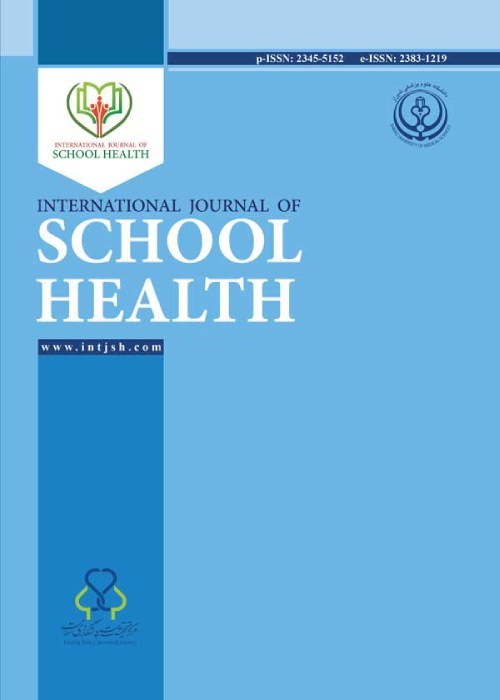فهرست مطالب

International Journal of School Health
Volume:9 Issue: 4, Autumn 2022
- تاریخ انتشار: 1401/10/13
- تعداد عناوین: 8
-
-
Pages 205-214BackgroundSchool health and nutrition programmes improve the health and nutritional status of learners, yet their implementation status in Zambia remains unknown. This study aimed to explore the implementation of school health and nutrition programme in one of the districts in Zambia.MethodsThis was a descriptive, cross-sectional study conducted in Lusaka district, in 2015. The participating schools, including only state schools in Lusaka district were selected using stratified sampling method. Community and privately owned schools were not included. Herein, 40 school health and nutrition programme coordinators completed a questionnaire based on the guidelines provided by the Ministry of Education. Quantitative data were analysed via Microsoft Excel and Stata. The data obtained from open-ended questions were subjected to content analysis with prominent themes generated.ResultsA School health and nutrition programme was observed in 42.5% (n=17) of the schools, but with no significant differences (P=0.601) between the urban and peri-urban ones. Due to insufficient funds and lack of supervision, only some of the recommended activities were implemented, such as school gardens, deworming, vitamin A and iron supplementation, and health education. The schools implementing school health and nutrition activities noted positive changes such as improvement in school attendance, pass rate, and a reduction in diarrhoea and bilharzia among their learners.ConclusionSchool health and nutrition programme was implemented by less than half of the schools, still only partially. The effective implementation of the school health and nutrition programme is crucial to improve the health and nutritional status of learners. This necessitates that the Ministry of Education consistently follow up on school health and nutrition implementation.Keywords: School Health, Nutrition programme, Health promotion, Micronutrient supplementation, School learners, Zambia
-
Pages 215-224BackgroundAfter the outbreak of coronavirus disease 2019 (COVID-19), this study aimed to (1) identify whether the impacts of the COVID-19 pandemic on students’ academic achievement differed according to their sex among Korean adolescents, and (2) investigate the health-related behavioral factors affecting their academic achievement during the COVID-19 pandemic.MethodsHerein, secondary data of the cross-sectional 15th–17th (2019–2021) Korea Youth Risk Behavior Web-based Survey were used, targeting adolescents in middle and high school. A total of 167,099 individuals were selected and analyzed for selfreported academic grades and health behaviors using ordinal logistic regression analysis of the obtained results were compared to the pre-COVID-19 pandemic data in this regard (2019).ResultsHigh academic achievement in male adolescents significantly declined from 15.4% to 13.7% or 14.0% in 2019, 2020, and 2021, respectively. Compared to 2019, lower academic achievement was found in boys in 2020 and 2021 (odds ratio [OR]=0.93,95% confidence interval [CI]=0.89-0.97, P=0.002 and OR=0.95, 95% CI=0.91-0.99, P=0.010) while no significant differences were observed in girls. In boys in 2020 or 2021, the lowered academic achievement was associated with the time of internet use for leisure during both weekdays and weekends, unhealthy health status, poor self-perceived health, a “fat” body image, stress, and skipping breakfast, stress, which increased during the COVID-19 pandemic, as well as engaging in personal hygiene, smoking, and alcohol drinking (P<0.05).ConclusionsTo improve academic achievement in the ongoing COVID-19 pandemic, it is necessary to develop and implement interventions, especially for male students, focusing on health management and targeting the associated health behaviors.Keywords: COVID-19, Adolescents, Academic success, Health Behavior, Korea
-
Pages 225-231BackgroundPuberty is known to be a stressful period for students, and managing its associated crises helps guarantee students’ mental health and sense of well-being in adulthood. This study aimed to investigate the mediating role of academic engagement in the correlation between cognitive and metacognitive strategies and academic well-being in high school students.MethodsThe method used in this research was descriptive and correlational. The statistical population included all the female high-school students in Kermanshah, Iran, in 2021, out of whom a sample of 350 students was selected. The Standard Schoolrelated Well-being Questionnaire, the Learning Strategies Questionnaire, and the Academic Engagement Scale were utilized herein. The data were analyzed with descriptive and inferential statistics (structural equation modeling).ResultsThe results revealed that cognitive (r=0.34, P=0.001) and metacognitive (r=0.36, P=0.001) strategies were significantly and positively correlated with academic well-being. Furthermore, cognitive (r=0.33, P=0.001) and metacognitive (r=0.42, P=0.001) strategies were significantly and positively correlated with academic engagement. These strategies also had an indirect and significant association with academic well-being mediated by academic engagement (P=0.001).ConclusionsThe results demonstrated the desirable fit of the model. It could be therefore recommended that cognitive and metacognitive strategies be instructed to students in order to promote their academic well-being by increasing their academic engagement.Keywords: Health, Cognitive psychology, Metacognition, Engagement, Students
-
Pages 232-240BackgroundIn Japan, cancer education utilizing external lecturers are being promoted as part of cancer control measures. The objective of this study was to clarify children’s perceptions of cancer and survivors and their awareness of actions for early prevention and detection of cancer after participating in a cancer education program engaging with survivors.MethodsThis study was conducted during January and March 2020, using the qualitative analysis method. Homeroom teachers gave a lesson on cancer to sixth-grade students (n=69) at an elementary school in Japan. Two weeks later, a cancer survivor gave a follow-up class. Then an inductive content analysis was conducted on the content of the post-class reflection worksheets written by students.ResultsAfter analyzing the worksheets of 59 students, they learned that “to reduce the risk of developing cancer, one should lead a healthy lifestyle” and “strive for early detection through cancer screening” through the education program. As things they can do themselves in the future, they listed “encourage family members to get cancer screenings,” “quit smoking,” and “cut back on alcohol.” In addition, children have deepened their understanding of cancer survivors and learned the importance of their own and others’ lives.ConclusionThe results suggested that children gained practical knowledge about cancer through the program and deepened their understanding of cancer and survivors by directly interacting with and listening to survivors.Keywords: Health promotion, Child, Cancer survivors, Schools, Cancer education
-
Pages 241-248Background
Students with learning disabilities experience cognitive, emotional, behavioral, and social problems. The present study aimed to investigate the role of brain gym exercises and filial play therapy on students with specific learning disorders (SLD) emotion management skills.
MethodsThis quasi-experimental study was conducted through a pretest-posttest–follow-up design with a control group. The statistical population included all students with SLD and their mothers in Tehran, Iran within 2020-2021 period. The convenience sampling method was employed to select 45 students with SLD, who were then randomly assigned into two experimental groups and one control group. The participants in the first experimental group received brain gym exercises, whereas those in the second experimental group attended a filial play therapy intervention. The participants in the control group received no intervention. The Children’s Emotional Management Scale (CEMS) was used to collect data. The ANCOVA was then adopted for data analysis.
ResultsThe mean±SD of the post-test scores of inhibition, dysregulation, and coping in the brain gym exercises group were 21.73±2.84, 20.00±2.82, and 23.13±3.37, respectively. Moreover, the mean±SD of the post-test scores of inhibition, dysregulation, and coping in the filial play therapy group were 20.53±3.44, 21.53±2.10, and 22.80±3.74, respectively, which were significantly different from the control groups. The results showed that both brain gym exercises and filial play therapy were effective in improving emotion management skills (i.e., inhibition, dysregulation, and coping) in students with SLD (P<0.001). Furthermore, these two interventions had no significant differences regarding their effects on emotion management skills.
ConclusionsIt can be concluded that brain gym exercises and filial play therapy help improve emotion management skills in students with SLD.
Keywords: Specific Learning Disorder, Emotions, Brain, Play Therapy, Students -
Pages 249-256BackgroundChildren with learning disabilities have cognitive impairments not attributable to their intelligence. The present study aimed to evaluate the effectiveness of Hesabyar Cognitive Rehabilitation on neuropsychological functions of children with special learning disabilities.MethodsThis was a quasi-experimental study which had pre-test and post-test design and conducted with a control group. The statistical population included all the male elementary students with special learning disabilities in Semnan, Iran, in the academic year 2019-2020. The sample consisted of 40 students (20 participants in each group) with special learning disabilities that were treated. The Conners Psychological Scale was used for data collection. The experimental group underwent cognitive load rehabilitation every other day for 10 sessions while the control group did not receive any treatment. The data were analyzed using the statistical method of multivariate analysis of covariance and SPSS version 24.ResultsThe mean±SD of age in the experimental group and the control group were respectively 11.2±0.9 and 11.5±0.8. The results of ANCOVA analysis showed that Hesabyar Cognitive Rehabilitation program made significant changes in components of variables, including selective attention (P=0.002), sustain attention (P=0.001), attention shifting (P=0.001), attention divided (P=0.004), attention span (P=0.002) l-term memory (P=0.011) [components of difficulty in memory function and learning], executive functions (P=0.001), problem with speed and cognitive processing ability (P=0.016), as well as components of academic performance problems, namely attention functions (P=0.004), computational science (P=0.002), argument/calculations (P=0.014), and attitudinal discussions (P=0.001) [components of academic performance problems: mathematics].ConclusionBased on the findings of this study, Hesabyar Cognitive Rehabilitation program is one of the treatments that can be used to minimize the problems of students with math learning disorders.Keywords: Hesabyar cognitive rehabilitation, Psychopsychological functions, Specific learning disorders
-
Pages 257-263Background
Dyscalculia and dysgraphia are among the prevalent problems faced by students with specific learning disorders (SLD). The present study aimed to investigate the role of balance enhancement exercises in improving dyscalculia and dysgraphia among students with SLD.
MethodsThis was a quasi-experimental study with a pretest-posttest design and a control group. The statistical population of this study included all boy and girl second-graders and third-graders with SLD who received education and rehabilitation services from public and private centers for learning disabilities in Ahvaz, Iran in 2022. The convenience sampling method was employed to select 30 participants who were equally assigned to experimental and control groups (i.e., 15 per group). The experimental group received balance enhancement exercises (for twelve 45-minute sessions), whereas the control group received no interventions. To collect information, the Dyscalculia Test and Dysgraphia Test were used. The ANCOVA was then used for data analysis.
ResultsThe mean±standard deviation (SD) of the post-test scores of dyscalculia and dysgraphia in the experimental group was 106.93±14.99 and 75.60±15.10 which was significantly different from the control groups (91.33±14.45 and 60.93±19.36). The results indicated that balance enhancement exercises improved dyscalculia and dysgraphia in students with SLD (P<0.001).
ConclusionAccording to the results, balance enhancement exercises can be employed to boost academic achievement by improving dyscalculia and dysgraphia in students with SLD.
Keywords: Specific Learning Disorder, Dyscalculia, Agraphia, Students -
Pages 264-268Although health anxiety is a rare type of anxiety in adolescents and children, it has a negative impact on their mental health. Health anxiety refers to worries and fears about one’s health and physical sensations. The current study aimed to examine the correlation of early maladaptive schemas with automatic negative thoughts and health anxiety in school students.This correlational research was conducted in 2022 in Tabriz, Iran. The participants were 200 students recruited through convenience sampling method. To collect data, we used the Health Anxiety Inventory, Automatic Thoughts Questionnaire, and the Young Schema Questionnaire- Short. The early maladaptive schema’s factors were significantly correlated with health anxiety and automatic negative thoughts (P=0.001). Early maladaptive schemas are pervasive dysfunctional themes or patterns that negatively impress people’s thoughts and lead to misinterpretations about internal and external events.Keywords: Early Maladaptive Schemas, Health anxiety, Automatic negative thoughts, Student


